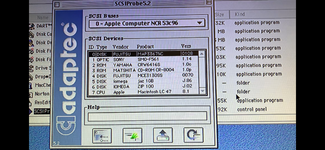sorry @ArmorAlley was rereading now and noticed your post, i'll just note that although not many 'getting started' people would run into them i'll nevertheless suggest that if someone new to buying into a mac hobby sees a scsi drive that has one big single rear interface (eg https://disktransfer.co.uk/IMAGES-fs/scsi-sca-80-pin-hdd-for-data-transfer.jpg ), do not buy it .. what you saw basically is 'sca 80' or a form of more modern lvd/hvd ultrascsi
[I only wanted to mention this because apparently a sca hdd can be had in very low capacity so it would be too easy to think that a 4gb drive you found in a local ad would go with your new first vintage mac but..umm..yeah..]
[I only wanted to mention this because apparently a sca hdd can be had in very low capacity so it would be too easy to think that a 4gb drive you found in a local ad would go with your new first vintage mac but..umm..yeah..]

